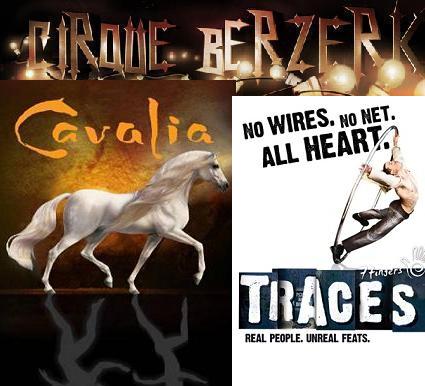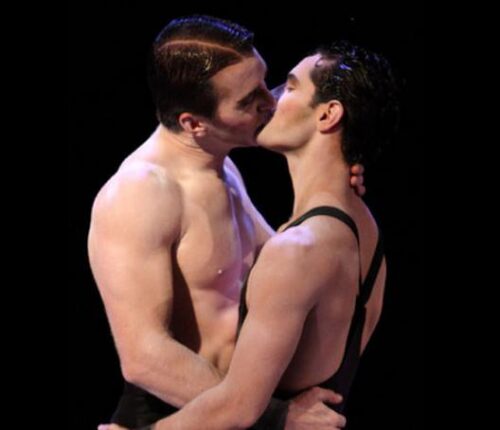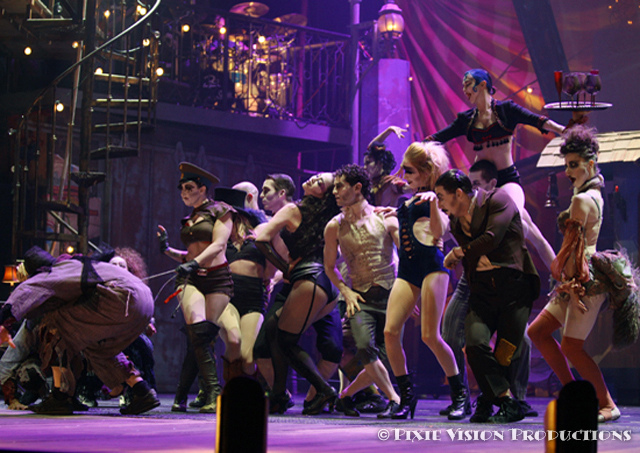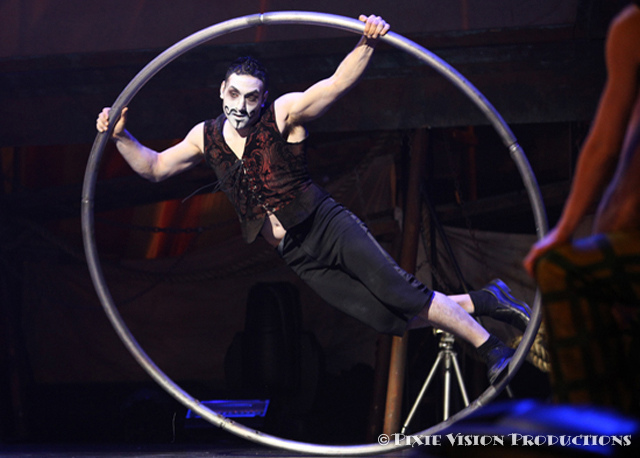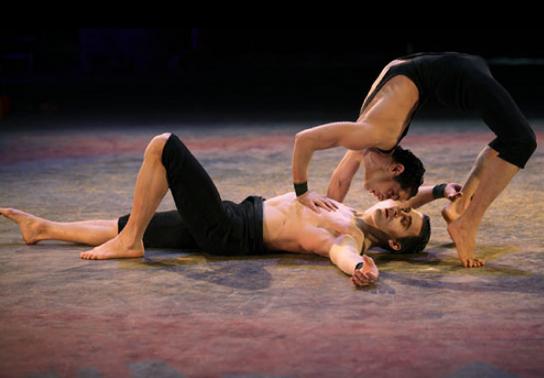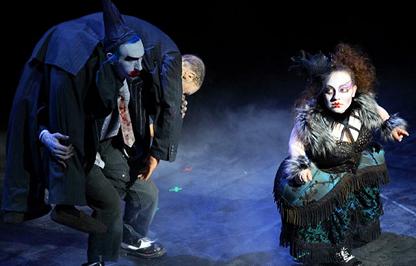THIS CITY HAS BECOME A CIRCUS
Erica Jong said, “Every country gets the circus it deserves. Spain gets bullfights. Italy gets the Catholic Church. America gets Hollywood.” And what does Hollywood get? Three circus-themed diversions of derring-do opening in the same week: Traces, which is a terrifically tantalizing titillation by seven convivial yet streetwise twenty-somethings who serve up a panoply of pulsating calisthenics that will leave you tickled pink; next is Cavalia, a mixed (oat)bag where equestrian trick riders and acrobats take a back seat to a soul-stirring spectacle of forty-nine horses, beautiful music, and stunning scenery; and, finally, there is Cirque Berzerk, a sumptuous Saturnalia of sweat, sin, and the supernatural which, although it contains many astounding acts, ultimately suffers from silly storytelling, sloppy segues, and its placement in one of the worst venues ever for a theatrical event, Club Nokia.
* * * * * * * * * * * * * * * * * * * * * * * * *
The irony is that the production which is handstands-down the best of the pack is the one with the simplest production values. That would be Traces, the second show from the Montreal-based company, 7 Fingers (Les 7 doigts de la main). (More ironic still is that their third creation, La Vie, takes on darker, sexier themes a la Cirque Berzerk.) This is an intimate circus with an inner-city flavor that harks back to the street performances in Montreal, the ones which inspired the original Cirque du Soleil movement. Here, we have an urban update, as performers use skateboarding, basketball and municipal obstacle courses (parcours), along with traditional acts, such as the diabolo, a two-headed top thrown up and caught with a string stretched between two sticks (a.k.a. the Chinese yo-yo).
The seven performers in Traces are multi-disciplined: they sing, play musical instruments and excel in gymnastics and dance. Without all the trappings of a giant Cirque show, we get what this is about—youth and prowess. When the entire troupe dexterously bounces and straddles between two fire poles with the proficiency of spider monkeys, it’s a wonder that their arms don’t come right out of their sockets.
A theatergoer near me said, “How am I supposed to describe this to my friends?” Well, you can’t. Because what we ultimately want to do is to describe the experience, like a beautiful sunset. When Traces ends, you will be wound-up, inspired and (unless you have one foot in the grave and another on a banana peel) turned on. For, as Robert Benchley said, “You see in the circus a gathering of men and women who are able to do things as a matter of course which you couldn’t do if your life depended on it.” And that’s hot.
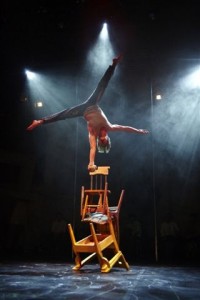 The cast of six men and one woman exudes personality, but, like many of us at 24 years of age, they’re, like, so aware of how unaware of themselves they are. They tell us bits and pieces about themselves into a microphone that dangles from the rafters. “I’m impatient” or “I’m unfocused.” It is cute bordering on saccharine. I wonder how important these traits would have seemed if we didn’t want to sleep with every one of them.
The cast of six men and one woman exudes personality, but, like many of us at 24 years of age, they’re, like, so aware of how unaware of themselves they are. They tell us bits and pieces about themselves into a microphone that dangles from the rafters. “I’m impatient” or “I’m unfocused.” It is cute bordering on saccharine. I wonder how important these traits would have seemed if we didn’t want to sleep with every one of them.
Still, the show is refreshingly free of pomposity, and the acts sparkle with originality. Not since the MGM musicals of yore would I have imagined someone dancing with just a book and an armchair—move over Fred Astaire and welcome Valérie Benoît-Charbonneau. Later, after an adroit balancing act on chairs, Florian Zumkehr sits down and, with nary a pant, sings a ballad while accompanying himself on guitar; the testosterone necessary for him to pull off that one-two punch is worth the price of admission. I’m also thrilled that Zumkehr doesn’t have a legit voice, because he called to mind a solo traveler I saw in Europe who sang for his supper—it’s that lack of pretension that keeps Traces grounded in our hearts. Thus, when the cast pulls out all the cheekiness and mugging possible while skateboarding around the stage to a peppy rendition of “Paper Moon,” the effect at the Ricardo Montalbán Theatre is unspeakably adorable.
* * * * * * * * * * * * * * * * * * * * * * * * *
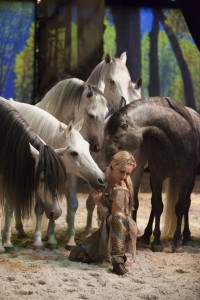 There is a psychosomatic illness known as Stendhal’s Syndrome that causes (among other effects) dizziness and confusion when one is exposed to too much beautiful art. Even at the best museums in the world, one can experience “museum burnout” after two hours. Cavalia, the resplendent Cirque-styled equestrian extravaganza is a remarkable endeavor, but for all of its gorgeous settings, exotic performers and compassionate interaction between human and horse, the wondrous majesty becomes a bit numbing.
There is a psychosomatic illness known as Stendhal’s Syndrome that causes (among other effects) dizziness and confusion when one is exposed to too much beautiful art. Even at the best museums in the world, one can experience “museum burnout” after two hours. Cavalia, the resplendent Cirque-styled equestrian extravaganza is a remarkable endeavor, but for all of its gorgeous settings, exotic performers and compassionate interaction between human and horse, the wondrous majesty becomes a bit numbing.
It is nigh impossible not to be amazed by the equine artistry (if you have a daughter who is into horses and gymnastics, she just might faint), but you may find yourself unmoved by the entire experience, largely because Cavalia is only as good as the last act you witnessed: One moment you’re enthralled watching eight gorgeously costumed riders on white horses executing the grapevine in unison—the next you’re underwhelmed by aerialists on bungee cords. You may also remain unmoved 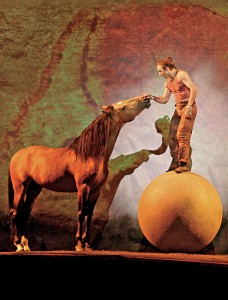 because the bleacher-style seats are ridiculously uncomfortable, calling to mind the mule ride to the bottom of the Grand Canyon. Plus, from where I was sitting in row Q, all it took was one head in front of me to block a third of the stage. Any particular reason why the seats are not staggered?
because the bleacher-style seats are ridiculously uncomfortable, calling to mind the mule ride to the bottom of the Grand Canyon. Plus, from where I was sitting in row Q, all it took was one head in front of me to block a third of the stage. Any particular reason why the seats are not staggered?
There are many reasons why Cavalia has been seen by 2.5 million people around the world since it began in Canada in 2003. One is a scene named the Grande Liberté, which you will never forget as long as you live: Horse Whisperer Sylvia Zerbini (who comes from a nine-generation French circus family) casts a spell as she commands nine unencumbered Arabian horses with a nod of her head or a flick of her hand. While some horses prance about as if they were wild on the prairie, others rear or lay down at Zerbini’s sway. An autumnal scene is projected on a 210-foot wide screen while falling leaves shimmer in the dappled lighting. Lit behind the scene is guitarist Raphaël D’Amours who magnificently executes a haunting new-age composition by Michel Cusson. Soon, the horses are swirling in a trotting roundelay on 2,500 tons of sand and dirt, and the moment of inimitable theatricality is poetic, haunting, adorable and mesmerizing.
Duri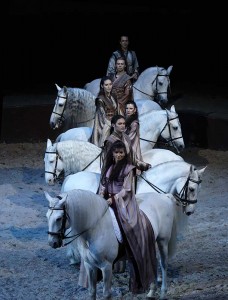 ng the next act, involving trick riders, some of the audience members around me began to yawn, as I did. I suspect that, as with Stendhal’s Syndrome, we were just getting burnt out by the magnificence of it all. If you are willing to spend the money, make sure you sit closer up in the center. Your kids will be eternally grateful. As for me, it was as if I had been overfed a wondrous seven course meal, yet I could still eat a horse.
ng the next act, involving trick riders, some of the audience members around me began to yawn, as I did. I suspect that, as with Stendhal’s Syndrome, we were just getting burnt out by the magnificence of it all. If you are willing to spend the money, make sure you sit closer up in the center. Your kids will be eternally grateful. As for me, it was as if I had been overfed a wondrous seven course meal, yet I could still eat a horse.
* * * * * * * * * * * * * * * * * * * * * * * * *
Cirque Berzerk was born out of the desert, in the annual artistic subculture event known as Burning Man. It combines elements of most Cirque shows (such as circus acts, choreography, and original otherworldly music) but with a decidedly darker and palpable sexuality. A highlight is an aerial pas de deux by two men; the strength, agility, and grace are simply stunning. More stunning still is that the decidedly homoerotic act is sealed with a passionate kiss. That Cirque Berzerk considers the show all-age-appropriate (and that the audience roared in approval) illustrates just how far society has come.
After a confusing opening (it’s unclear where the pre-show leaves off and the show begins) we descend into the underworld via the Woman in Red, the positively stunning Emilie Livingston, who is ready to ditch the real world. She signs a contract with Death, who invites her to witness Death’s Cabaret. Portrayed by writer, composer and co-founder Kevin Bourque, Death sounds like a peeved sales clerk from an I Love Lucy episode and is about as scary as Pee-Wee Herman.
If the Woman can not perform a circus act as well as the ones on display, she will turn into a servant ghoul forever. Let me see if I get this straight: Becoming a servant to abusive Mr. Death for eternity is the reward, but becoming a breakdancing servant to the enslaved is punishment in Hell? What the hell? Four writers are credited, but no story appears; the use of ghouls for circus acts is a wonderful idea, but the show circumnavigates the deeper meaning of selling one’s soul to the devil; as such, Berzerk ends up being a vaudeville of side-show freaks with none of the Faustian implications. There is no resonance, no tension, no fright and no philosophy—which is not to say that there aren’t some astonishing and riveting performances percolating with personality.
The “oohs” and “aahs” can indeed be heard from the audience during individual acts, such as the 21st-century Cyr Wheel (or roué Cyr), a large, metal hoop that an acrobat uses to gyrate around the stage (also used in Traces). Another winner is four trampoline artists bouncing over a high wall. In fact, many of the acts are extraordinary, but director John Carrafa has not yet figured out where each act should go and how they meld into one another. When Miss Livingston performs her solo aerial ring act, of course she is lithe and beautiful, but it absolutely fails as a climax to this phantasmagoria.
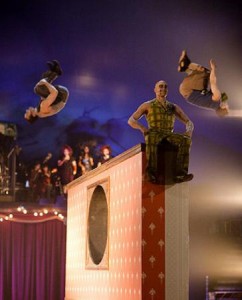 The acoustics seem marvelous until we realize that we could barely discern the lyrics. Bourque’s compositions are a combination of tribal, opera, and world music, all sung by superlative soprano Gretchen McNeil, and backed by fantastic musicians. The lyrics, when audible, cleverly contained themes of Death (“I get High-Dee, High-Dee High when I’m Low-Dee, Low-Dee Low”). But honestly, for much of the show, we had no idea that the lyrics were even in English!
The acoustics seem marvelous until we realize that we could barely discern the lyrics. Bourque’s compositions are a combination of tribal, opera, and world music, all sung by superlative soprano Gretchen McNeil, and backed by fantastic musicians. The lyrics, when audible, cleverly contained themes of Death (“I get High-Dee, High-Dee High when I’m Low-Dee, Low-Dee Low”). But honestly, for much of the show, we had no idea that the lyrics were even in English!
For all the hard work that was put into the show (my God, the talent!), it remains a hollow and uneven effort, as if a chef had concentrated on the garnish and ignored the meat. The creators of Cirque Berzerk attempt to escape the more mundane Cirque shows by seasoning it with darkness—it’s Sweeney Todd meets French Burlesque. Unfortunately, its inability to concentrate on substance as much as style (and its tepid attempts at comedy, particularly the antics of a matronly dwarf), leave us feeling flat and that somehow we have seen all of this before. More’s the pity that Berzerk does not leave a lasting impression; its clunky construction detracts us from all of its amazing performances and breathtaking acts.
Indeed, the ghastliest thing about the evening was the theater itself. Well, Club Nokia isn’t a theater; it’s a club. Previous acts, such as the Fab Four’s impersonation of the Beatles, fared well because they largely remained center stage. Cirque Berzerk fills the entire 3-story stage. Therefore, most of the people standing around a bar on 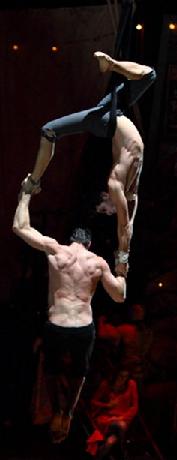 the main floor could not see the aerial acts, as they were blocked by the 900-seat stadium-styled balcony, which, although it is impressively raked, affords very few people a clear view of the stage. Plus, the apron (or front) of the stage disappears under the balcony, causing people sitting there to lean forward in a domino effect, essentially blocking each other’s view of the whole stage. If you sit on the side of the balcony then one-third of the stage vanishes.
the main floor could not see the aerial acts, as they were blocked by the 900-seat stadium-styled balcony, which, although it is impressively raked, affords very few people a clear view of the stage. Plus, the apron (or front) of the stage disappears under the balcony, causing people sitting there to lean forward in a domino effect, essentially blocking each other’s view of the whole stage. If you sit on the side of the balcony then one-third of the stage vanishes.
The show started 35 minutes late, ushers didn’t seat latecomers (who had to deal with those who stole their seats for a better view), cocktail waitresses blocked the view as they walked up and down the balcony, and programs weren’t passed out (I found one in a dark cubbyhole). Cool VIP lounges do not compensate for poor theater management.
At another venue, Cirque Berzerk may be somewhat recommended, but at Club Nokia, which includes hefty drink prices, a confusing layout, and the negotiation of heavy downtown traffic, I have to side with Mark Twain, who said, “I ain’t opposed to spending money on circuses, when there ain’t no other way, but there ain’t no use in wasting it on them.”
* * * * * * * * * * * * * * * * * * * * * * * * *
photos by Michael Meseke (Traces); Jean-François Leblanc, Lynn Glazer,
Frédéric Chéhu (Cavalia); Pixie Vision Productions (Cirque Berzerk)
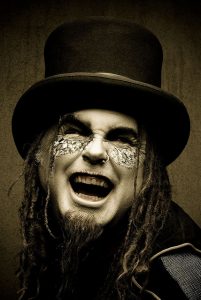 Traces
Traces
Ricardo Montalbán Theatre
1615 Vine St. in Hollywood
Tues-Fri at 8; Sat at 2 & 8; Sun at 1 & 6:30
ends on February 20, 2011
for tour info, visit 7 Doights
Cavalia
777 N. Front St. in Burbank
Tues-Fri at 8; Sat at 3 & 8; Sun at 2
ends on February 15, 2011
for tickets and tour info, visit Cavalia
Cirque Berzerk
Club Nokia in Downtown L.A.
ends on January 30, 2011
for tickets, visit Cirque Berzerk
